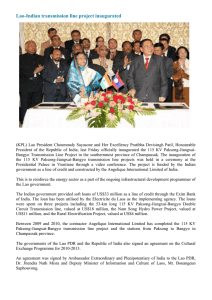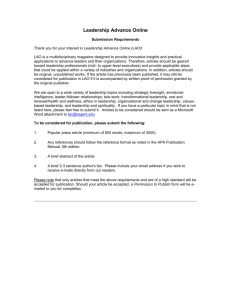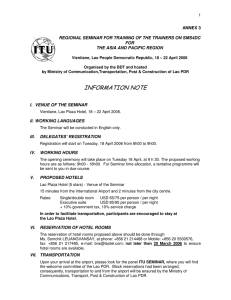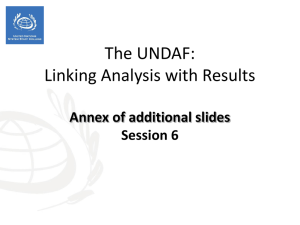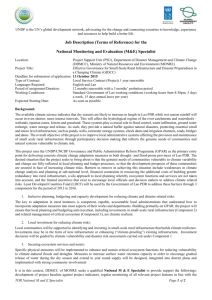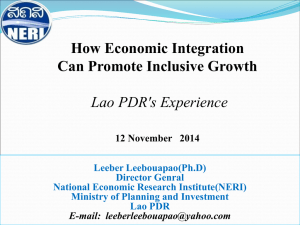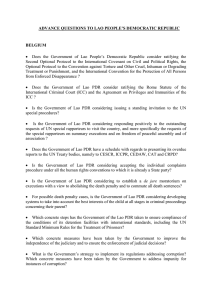2 Example - Lao Presentation - Prof Sam Blay - Sept 2010
advertisement
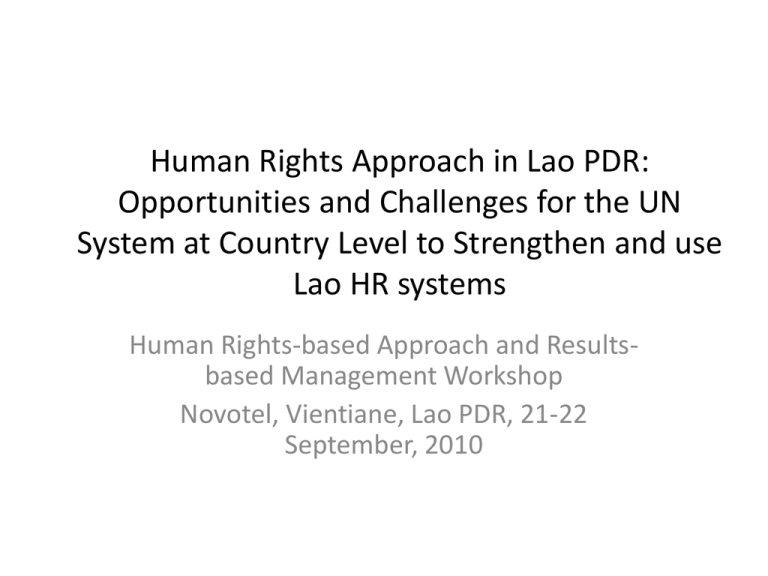
Human Rights Approach in Lao PDR: Opportunities and Challenges for the UN System at Country Level to Strengthen and use Lao HR systems Human Rights-based Approach and Resultsbased Management Workshop Novotel, Vientiane, Lao PDR, 21-22 September, 2010 Introduction: National Human Rights Protection System (NHRPS) • The NHRPS – The national policies and institutions that promote and protect human rights. – The total human rights infrastructure: • all of the checks and balances needed to ensure that state institutions are accountable and fulfill their duty to respect, protect and uphold human rights • 2 essential elements of the NHRPS – international human rights standards must be fully incorporated and reflected in national laws and policies – National institutions and civil society should have the means, capacity and backing to implement and or oversee these laws and policies The NHRPS Institutions •Judiciary •Legislature •Law enforcement agencies •Administrative agencies Domestic law Policies Civil society/Human rights Defenders •Integration of international standards •Subject specific laws protecting human rights •Human rights education and and awareness programs •National action plans •Rights based approach in national programs and policies •Access and ability to contribute freely to the promotion and protection of HR The Lao PDR Country Context: International HR Instruments • The Lao PDR is a party to six core human rights conventions and two optional protocols: – International Covenant on Civil and Political Rights (ICCPR), – International Covenant on Economic, Social and Cultural Rights (ICESCR), – International Convention on the Elimination of All Forms of Racial Discrimination (ICERD), – Convention on the Elimination of All Forms of Discrimination Against Women (CEDAW), – Convention on the Rights of Persons with Disabilities (CRPD), – Convention on the Rights of the Child (CRC) • Optional Protocol regarding the Sale of Children, Child Prostitution and Child Pornography, • Optional Protocol on the Involvement of Children in Armed Conflict. Lao PDR Country Context: The NHRPS • • The Constitution National institutions • • Law enforcement agencies Specific laws and decrees • Policy machinery – – – – – – – The Judiciary The National Assembly National Human Rights Centre Lao Bar Association Lao Front for National Construction The State Inspection Authority Central and Provincial authorities – Decree on Associations – The Law on complaints – The Law on media The Challenges: Causality linkages • The constraints of geography: – The major part of country’s territory is mountainous and yet to be developed. Access is limited • The legacy of war – The adverse effects of the destructive wars and armed conflicts, especially of UXO and other war remnants, constitute the major obstacle to the improvement of the living conditions of the people in remote rural areas • Poor educational background of state officials – persistent lack of understanding • Entrenched cultural beliefs – impact on health • Limited role for civil society – the Decree on Associations is little known and hardly encourages the formation and active engagement with civil society The Challenges: Causality Linkages • Lack of a Rule of Law culture – Lao PDR is a society in transition • Access to basic information on laws – Members of the public and state officials are sometimes not aware of laws the related to human rights • Human resources constraints – limited capacity in almost all areas of state activity • The Issue of ‘sensitive rights’: basic freedoms eg: – Freedom of speech – Freedom of association • The issue of minority rights – the definition of minority remain a controversial point with implication for minority rights protection • Reporting compliance – Capacity issues undermines the complaince The Opportunities and Potential Points of Intervention • An emerging culture of openness – This allows for open and healthy discussions and debates on human rights issues and a greater willingness to consider human rights questions • The acceptance of UPR Recommendations – This creates a legitimate basis for positive advocacy • A declared open commitment to the establishment of a Rule of State by 2020 – this further enhances legitimate expectations of the UN agencies and Development Partners • The ratification of the ICCPR – This serves as an important point of reference and creates and appropriate basis for assistance to the Lao PDR to align its laws with ICCPR principles and rules. The Challenge to UNCT: ‘Delivering as One’ • There is an increasing need to identify areas of synergies for coordination and concerted action • Example: Human trafficking: – – – – – – – – UNODC Poverty Reduction Unit UNICRI UNICEF UNIFEM ILO WFP UXO unit
